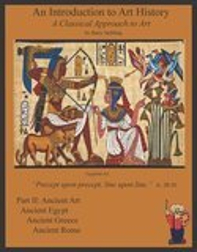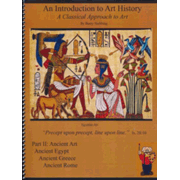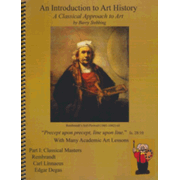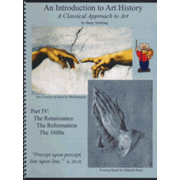An Introduction to Art History: A Classical Approach to Art is a series of courses covering art history, art appreciation, and work with art media. Six courses are available thus far:
- Part I: Studying the Masters
- Part II: Ancient Art, Egypt, Greece, and Rome
- Part III: Early Christian Art
- Part IV: The Renaissance and Reformation
- Part V: Landscape Painters: 17th, 18th, and 19th Centuries
- Part VI: Masters of Animals and Birds
One more course is in development:
- Part VII: Christian Artists
You can use these courses in whatever order you wish, although it makes sense to use the second through fifth courses in order since they flow chronologically. The publisher suggests most of these courses for students about second grade and above, but I think they will work better for those in grades four through twelve. Younger students are unlikely to have the historical background to which they can relate the art history in these lessons, and they might find some of the art projects too difficult. Students in seventh through twelfth grade might be able to work through the courses independently. The publisher intends for each course to take one year, but older students might complete two courses in one year.
In each course book, periodic true/false quizzes present questions on the historical information presented in the lessons. Answers are printed upside down at the bottom of each quiz page, so you would have to mask the answers if you want an accurate assessment of student knowledge.
Each course consists of a textbook and a set of Lesson and Masterpiece Cards that are printed on 8.5 x 11" cardstock sheets. The Lesson Cards provide models, partially drawn formats that make it easier for students to complete the drawings, or else blank spaces for all of the art projects. Most projects are done in small areas to keep them manageable. Students will use water-soluble markers, colored pencils, and a black drawing pen for the art projects. The Masterpiece Cards generally have two or more full-color images of artworks that are discussed within the lessons, and these artworks are often the inspiration for student art projects.
The history of art and architecture serves as the backbone for most of these courses, and students learn some information about the broader historical context within which these artworks were created. The amount of information is manageable even for fourth or fifth graders. There is just enough information to interest students without overloading them. Tying together historical events with developments in art makes both history and art more interesting. The treatment of history in these courses reflects a Protestant point of view, and predictably, this is particularly evident in Part IV: The Renaissance and Reformation.
A variety of art skills are taught in relation to the historical artworks. Students learn skills that are essential for drawing alongside those for working with other types of art media. These courses do not teach art skills in a sequence that moves from easy to difficult. For example, the first art lesson in Part III: Early Christian Art, has children use a pen to draw lines, breaking up a small, clownish figure called Professor Solomon into mosaic-like pieces. Next, they copy a mosaic of the head of Jesus into a small box then turn it into a mosaic as well. The first project should be easy while the second will probably be very challenging. There's no predictability since lessons sometimes teach relatively easy skills, and other times teach skills that are much more challenging. Parents might need to assist younger students or come up with adaptations for some projects.
Each course book comes packaged with a set of Lesson and Masterpiece Cards. You can order extra sets of the cards for additional students. You can also purchase the course book and cards in a bundle that includes a binder. (The Lesson and Masterpiece Cards are pre-punched with three holes for insertion into a binder.) There are also bundles for each course that include a set of high-quality art supplies so that you have everything you need for the course.
An Introduction to Art History: A Classical Approach to Art is labeled as a classical approach to art, but these courses should work well no matter what educational approach you use for other subjects.











